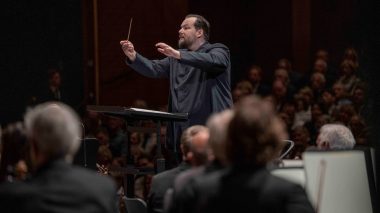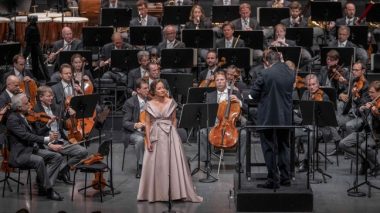
 Austria Salzburg Festival 2023 [1] – Berg and Mahler: Augustin Hadelich (violin), Christiane Karg (soprano), Vienna Philharmonic Orchestra / Andris Nelsons (conductor). Broadcast live (directed by Dick Kuijs) on STAGE+ from the Grosses Festspielhaus, Salzburg, 6.8.2023. (JPr)
Austria Salzburg Festival 2023 [1] – Berg and Mahler: Augustin Hadelich (violin), Christiane Karg (soprano), Vienna Philharmonic Orchestra / Andris Nelsons (conductor). Broadcast live (directed by Dick Kuijs) on STAGE+ from the Grosses Festspielhaus, Salzburg, 6.8.2023. (JPr)

Berg – Violin Concerto — ‘To the memory of an angel’
Mahler – Symphony No. 4 in G major
To Salzburg – if only virtually – for the Vienna Philharmonic Orchestra playing Berg and Mahler in an early morning concert.
Alban Berg’s Violin Concerto is Mahlerian in its plaintiveness and angst chiefly because of its connection to his widow Alma. Berg wrote the concerto – subtitled ‘To the memory of an angel’ – as a memorial to her daughter Manon, the child of Alma’s subsequent marriage to Walter Gropius. Manon died because of polio at only 18 and it is through a programme note by Paul Griffiths for a loickdown London Symphony Orchestra concert a couple of years ago we learn how ‘More than one angel, however, sings wordlessly in Berg’s music. Telling the story of Alma’s daughter, Berg remembered his own child, born of his teenage liaison with a kitchen maid at his family’s summer place in Carinthia. At the same time, the concerto draws electricity from his passionate involvement with the sister of Alma Mahler’s third husband (the writer Franz Werfel): Hanna Fuchs-Robettin as she then was, married to a businessman and living in Prague. Her initials and the composer’s are musically woven into the score, as are numbers Berg associated with each of them.’ Griffiths concluded how ‘The calamity that overtakes the concerto is partly that of the death of an angelic adolescent, partly that of an impossible love.’
Indeed the first two sections of the concerto (Andante, Allegretto) are meant to represent life, the last two (Allegro, Adagio) death and transfiguration. In fact Berg died shortly after completing the work, and the first performance of the Violin Concerto in 1936 was as much a memorial to Berg as to that ‘memory of an angel’. However difficult you might find the often expressionistic, discordant musical language of Berg it is impossible not to be deeply affected by what is essentially a requiem ohne Worte (without words). The work is based on a tone row; however, Berg adds to the mix fragments from an Austrian folk song and a Bach chorale.
Augustin Hadelich clearly was undaunted by the work’s numerous musical challenges and commanded attention throughout the concerto. Hadelich began softly – almost mournfully – and there was the evidence right from the start of the soloist’s excellent control and transparent clarity. Berg frequently takes the violinist to the upper limits of the instrument’s range but Hadelich – at least as heard through loudspeakers – was never swamped by the Vienna Philharmonic Orchestra who have a more supportive role in this concerto than they do in some others.
Hadelich – whose playing maintained a febrile energy throughout – was at his jauntiest in the dance-like Allegretto before there were the slashing chords of the Allegro where I admired the cadenza-like passages which demanded some impressively rapid fingerwork. Berg’s schizophrenic music veers between dramatic intensity and consolation and Nelsons – despite his head being in the score virtually throughout – consummately guided the VPO through to the transfigurative ending which is brought about by the Bach chorale ‘Es ist genug’ quoted in the extended elegiac close to the concerto. (This passage seems influenced by Vaughan Williams’s’ The Lark Ascending as a soul sounded as if it was rising to heaven.) Hadelich, together with Nelsons and his accomplished musicians, uncovered much musical detail along the way and as a result it was all profoundly moving. Hadelich’s encore was a gently reflective performance of Bach’s Andante from Sonata No.2 in A minor, BMV 1003.
Nelsons and the VPO appear to be working their way through a Mahler cycle at the Salzburg Festival, which – with a one-year break – has so far included Symphonies 2, 6, 3 and 5 and this year it was Symphony No.4. Mahler’s Fourth is one of his Wunderhorn ones when the composer borrowed from his earlier settings of texts from Des Knaben Wunderhorn (Youth’s Magic Horn), early nineteenth-century German folk poetry that had been collected and published by Achim von Arnim and Clemens Brentano. The Fourth Symphony is built around a song from this collection, ‘Das himmlische Leben’ (‘The Heavenly Life’), about such down-to-earth glories as feasting and singing in heaven. At one point, Mahler considered calling it a ‘Humoresque’ (thus inviting comparison with Dante’s The Divine Comedy) in the somewhat sardonic sense that life is a constant embarrassment of vanity and self-deceit, relieved on occasion by nobility and simple goodness.
The original title of ‘Das himmlische Leben’ was ‘Many Fiddles Hang in Heaven’. It was composed in 1892 and was originally to be the finale of the titanic Third Symphony. At some point Mahler decided this would be an anti-climax to an already huge piece and decided to compose an entirely new work (1899-1900, later revised) with this song as its final movement. This new symphony was to be more optimistic and cheerful and although plenty of childlike innocence can be heard, it would not be Mahler without hints of a parallel nightmare world intruding – often almost subliminally – from time to time. It was at these moments in the music that the account by Nelsons was rather too leisurely (at about one hour) and lowkey
Mahler planned this fourth movement for boy soprano and marks the score ‘singer’ without further instructions apart from saying that the voice must have ‘a happy childlike manner: absolutely without parody!’ Over the years, listeners have been delighted by the jingle of sleighbells with which the first movement opens, a feature which returns in the song. The German soprano Christiane Karg – at least as heard though loudspeakers – didn’t match Mahler’s requirements as much as I would like. It was lacking in wide-eyed innocence and the ending of the symphony just petered out for me.
So Nelsons brought a Haitink-like serenity to the music and, where others find more anxiety and tension, everything was mostly tranquil and nostalgic. It was clear – at least to me – that the wonderful Viennese musicians were enjoying playing the Mahler more than they did the Berg. It is important to note how for the opening of the Fourth Symphony and for the following Scherzo (in the style of a Landler) Mahler qualifies the tempo markings with the words (in German) ‘not hurried … very leisurely’ and ‘without haste’ and Nelson took this quite literally. Even with Reiner Honeck’s re-tuned violin intruding menacingly into the rich musical textures, Nelsons did not suggest that death is anything to be particularly frightened of.

Before the symphony’s apotheosis there was – given the doubts raised above – an admittedly ravishingly beautiful and extremely poignant slow movement, which I have may have heard equalled but perhaps not bettered. Mahler suggested that it reminded him of his mother’s smile and it is marked Ruhevoll (Restful) and Nelsons’s gently flowing tempo and sustained line produced outstanding results from the VPO, now playing at their very finest, most luminous, and transcendent. Eventually the music winds down before the orchestra explodes into a coruscating wall of sound representing the gates of heaven and ushering in the finale when, despite Christiane Karg making heaven seem somewhere we would all like to go to (if not too soon!) with its lavish meals and eleven thousand dancing virgins. For me, Karg failed to allow any of, what I suspect is, Mahler’s intended uneasiness to intrude – however fleetingly – into this heavenly vision when singing about ‘the butcher Herod’ and how ‘St Luke slaughters oxen’. The symphony ends with the child listening to the music of the angels, even when the joys of heaven might ultimately be unattainable.
If anything this Mahler Fourth Symphony will be remembered for some wonderful playing from the virtuosic – if typically mostly male – musicians, especially from Honeck’s violin, Ronald Janezic’s horn, Matthias Schorn’s clarinet, Sebastian Breit’s oboe, Anton Mittermayr’s timpani, and Charlotte Balzereit’s harp, amongst more who deserve also to be named.
Jim Pritchard
